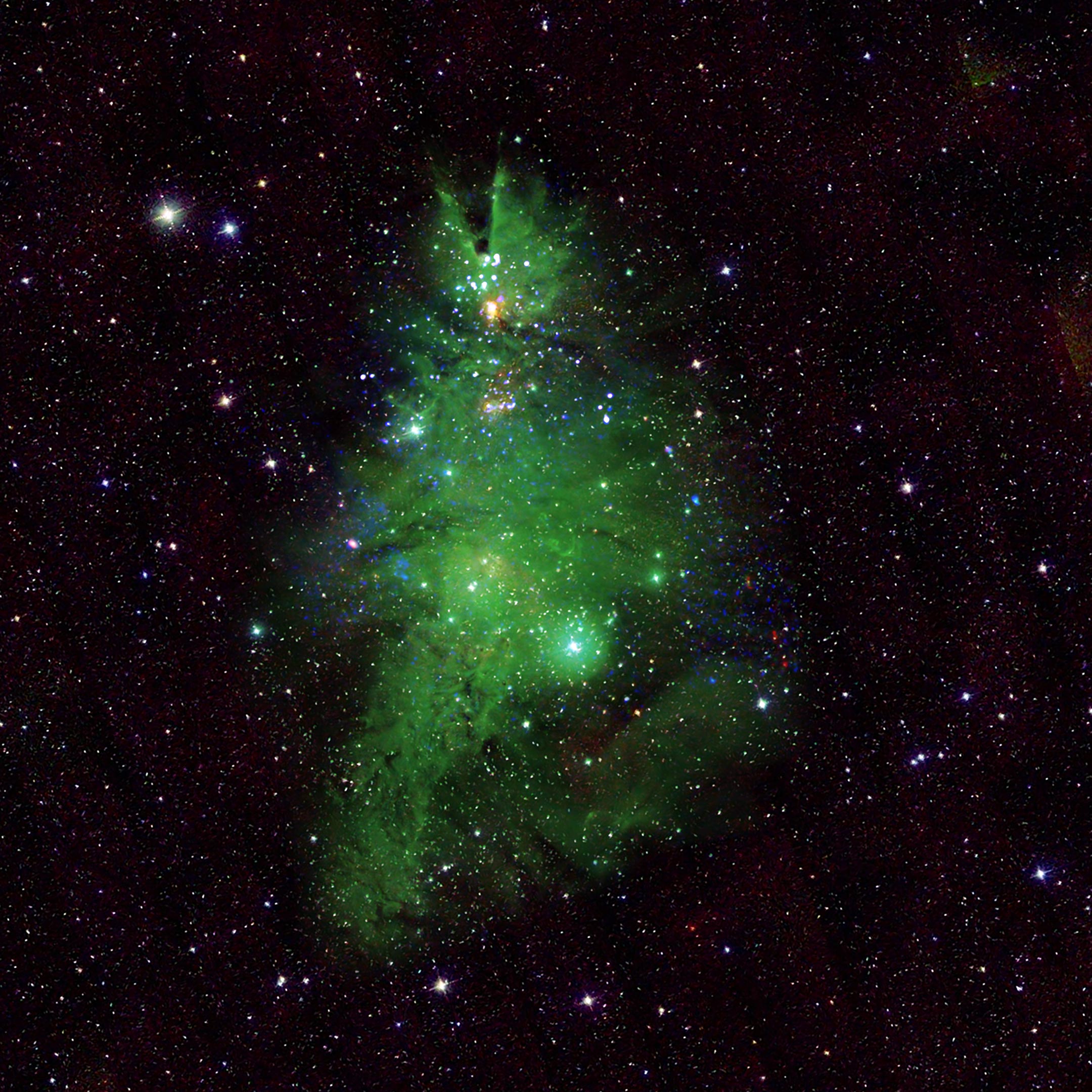The “Christmas Tree Cluster”, NGC 2264, is a group of young stars in the Milky Way, about 2,500 light-years from Earth. This composite image, enhanced by specific color selections and rotations, depicts these stars, in different sizes, as part of a cosmic Christmas tree. Source: X-ray: NASA/CXC/SAO; Optical: TA Rector (NRAO/AUI/NSF and NOIRLab/NSF/AURA) and BA Wolpa (NOIRLab/NSF/AURA); Infrared: NASA/NSF/IPAC/CalTech/Univ. From Massachusetts. Image processing: NASA/CXC/SAO/L. Fratari and J. Major
NGC 2264, the “Christmas Tree Cluster”, is a star cluster in the Milky Way Galaxy milky waydepicted in a newly enhanced image to resemble a cosmic Christmas tree.
- NGC 2264 is a cluster of young stars that have been colored and rotated to emphasize its “Christmas Tree Cluster” nickname.
- This composite image contains X-rays from Chandra (blue and white), optical data from WIYN (green gas), and infrared data from 2MASS (white stars).
- The age of the stars in this cluster ranges between one million and five million years, compared to the age of the Sun, which is 5 billion years.
- Young stars are volatile and produce powerful flares in X-rays and other types of light, but not in any coordinated way as shown in the animation.
Cosmic Christmas Tree: The stellar landscape of NGC 2264
This new image of NGC 2264, also known as the “Christmas Tree Cluster,” shows the shape of a cosmic tree with the glow of stellar lights. NGC 2264 is actually a cluster of young stars — between about one and five million years old — in our Milky Way Galaxy about 2,500 light-years from Earth. The stars in NGC 2264 are smaller and more massive than the Sun, ranging from some less than a tenth the mass of the Sun to others containing about seven solar masses.
Composite festive image: colors and rotation
This new composite image enhances the resemblance to a Christmas tree through color and rotation choices. The blue and white lights (which flash in the animated version – see video below) are young stars emitting X-rays that were discovered by NASAChandra X-ray Observatory. Optical data from the NSF-supported 0.9-meter WIYN telescope on Kit Peak shows a nebula of gas in the cluster in green, consistent with “pine needles” in a tree. Finally, infrared data from the Two Micron All Sky Survey show foreground and background stars in white. This image has been rotated clockwise by 160 degrees from the astronomer’s standard of north facing up, so that it looks like the top of the tree is toward the top of the image.
This composite image shows a Christmas tree assembly. The blue and white lights (flashing in the animated version of this image) are young stars emitting X-rays discovered by NASA’s Chandra X-ray Observatory. Optical data from the National Science Foundation’s 0.9-meter WIYN telescope on Kit Peak shows gas in the nebula in green, consistent with “pine needles” in a tree, infrared data from the Two Micron Survey show All Sky Survey Foreground and background stars in white. This image has been rotated clockwise about 160 degrees from the astronomer’s standard of north facing upward, so that it appears as if the top of the tree is toward the top of the image.
Stellar dynamics and observation techniques
Young stars, like the one in NGC 2264, are volatile and produce strong X-ray flares and other types of variations seen at different wavelengths of light. However, the flashing coordinated differences shown in this animation are artificial, to emphasize the positions of the stars seen in the X-ray and highlight this object’s resemblance to a Christmas tree. In fact, the star differences are not synchronized.
The differences observed by Chandra and other telescopes are caused by several different processes. Some are associated with activity involving magnetic fields, including flares like those on the Sun — but much stronger — and hot spots and dark areas on the surfaces of stars that come in and go as the stars rotate. There could also be changes in the thickness of the gas obscuring the stars, and changes in the amount of material still falling onto the stars from the surrounding disks of gas.
NASA’s Marshall Space Flight Center manages the Chandra program. The Smithsonian Astrophysical Observatory’s Chandra X-ray Center controls science operations from Cambridge, Massachusetts, and flight operations from Burlington, Massachusetts.

“Typical beer advocate. Future teen idol. Unapologetic tv practitioner. Music trailblazer.”






More Stories
‘It gave me goosebumps’: The most powerful gamma-ray burst ever observed was hiding a secret, scientists say
NASA’s Perseverance rover has found a rock on Mars that may indicate ancient life.
Northern Lights May Shine in Some States Tonight